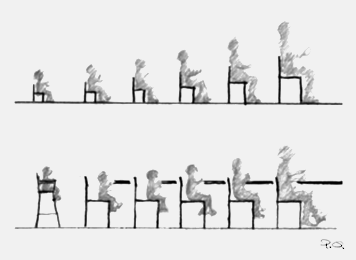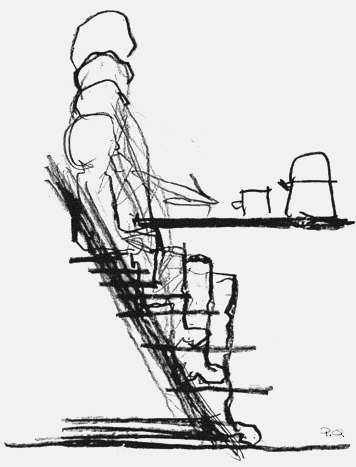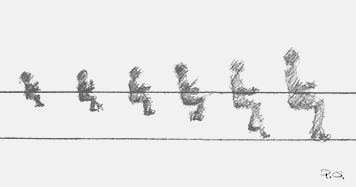Our oldest son was two years old and had outgrown his highchair. I looked for a chair that allowed him to continue to sit in a natural way and at a comfortable height at the grown-ups' table, and discovered that there weren't any chairs like that around. My first reaction was that this was a pity, but as a designer this discovery also entailed a challenge.

Before 1972
In 1972 the only sitting devices for children from the age of two onwards were special, low chairs, or ordinary chairs designed and intended for grown-ups.

Tripp Trapp was designed in 1972
My objective was that one chair should seat persons of all sizes from approximately 8 months and up, in a natural way at the same table.
I started by drawing all sizes of people with their elbows at tabletop level. Since the elbows and lower back are approximately at the same level, the chair’s backrest could be fixed at tabletop height. The only parts that had to be adjustable were the seat and the footrest. These had to be adjustable with regard to both height and depth. It is the feet that control most of our movements, also when we are seated. This is why it is important to have a broad and solid foot support adjusted at the correct height. This “floor” provides the child with posture control and it facilitates movement and a continuous change of sitting positions.
The concept should provide normal, functional dimensions for children of different sizes as well as adults. My hope was that this would make sitting at the table more enjoyable and make it easier to perform activities there. By having small children sit on a higher seat than adults, the height difference is reduced, improving interaction between children and adults. Mealtimes may become more relaxed, and children find it easier to concentrate on the activities taking place around the table when the physical environment has been adapted to their size and needs.

Visual form
The chair could have been given a visual form in tune with what was then the kitchen furniture trend. The side boards could have been shaped like the letter A, but I chose the shape of the letter L. This resulted in a distinct visual form that underscored the precise functional message and later the Tripp Trapp does not look outdated or old; on the contrary, it has become an icon.
Peter Opsvik´s thoughts about chairs and sitting
More about Peter Opsvik´s thoughts about sitting:
A historical view on sitting
Movement and variation
Tilting concepts
Favourite postures
Some thoughts on design
Environmental values
Rethinking sitting – the book